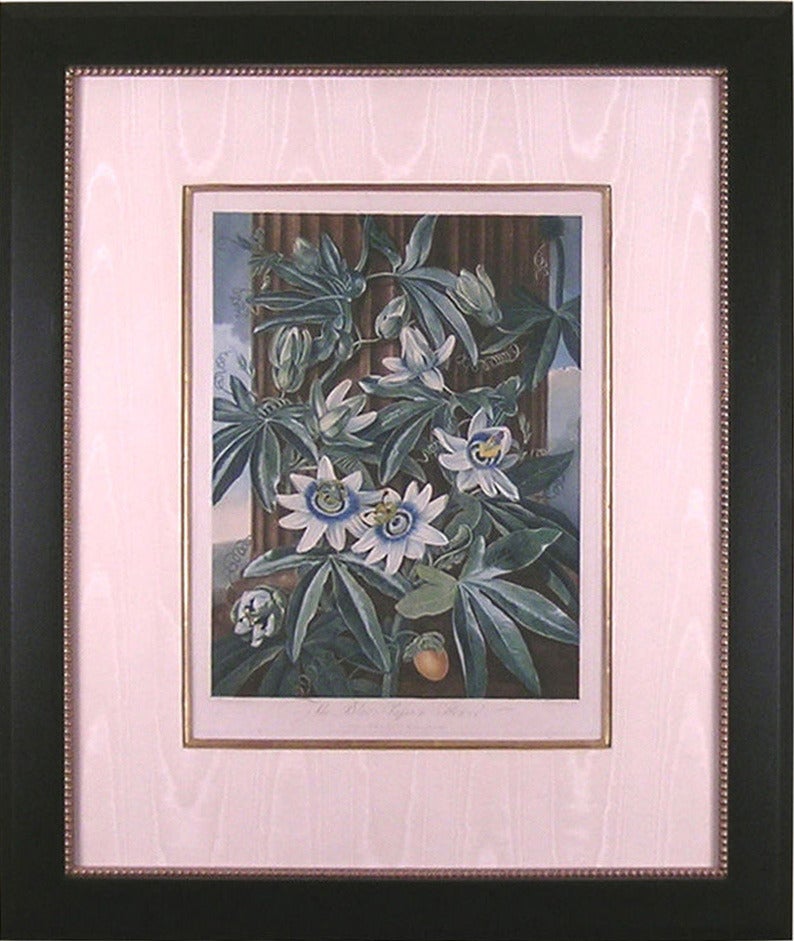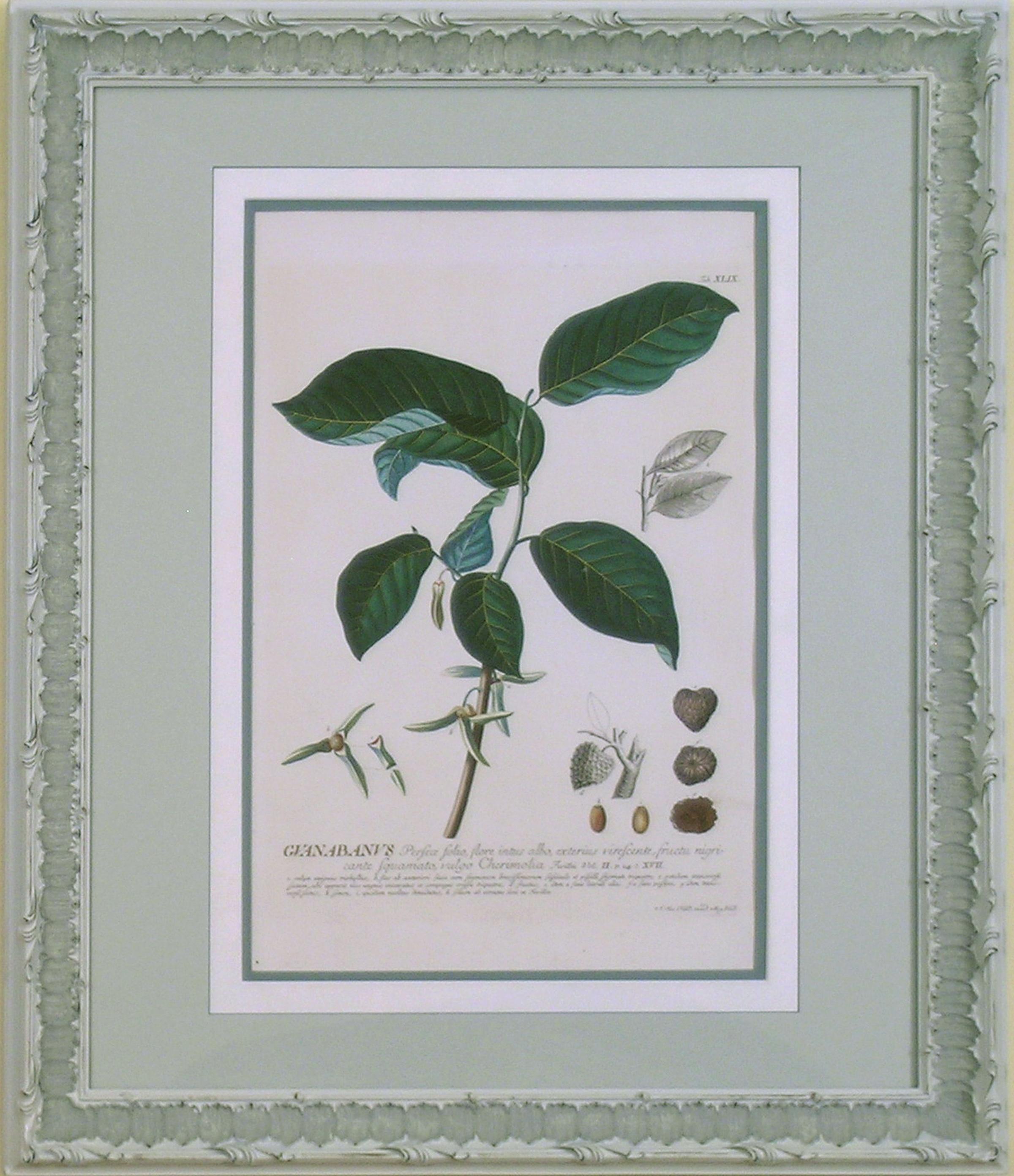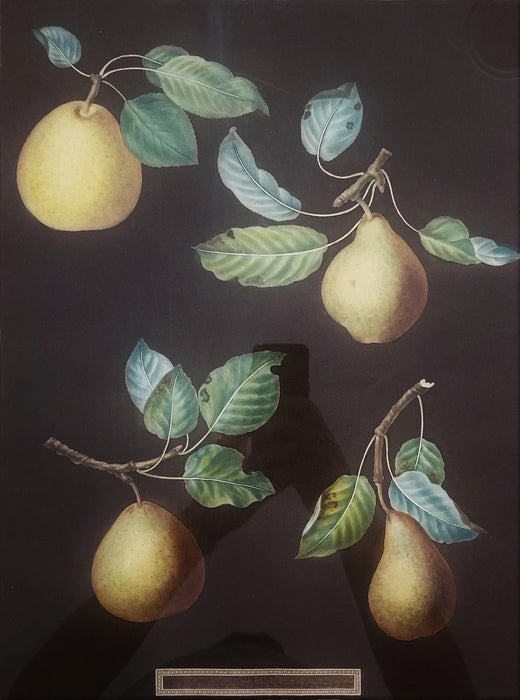George BrookshawPeaches XXVI1812
1812
About the Item
- Creator:George Brookshaw (1751 - 1823, British)
- Creation Year:1812
- Dimensions:Height: 27.5 in (69.85 cm)Width: 23 in (58.42 cm)Depth: 1.5 in (3.81 cm)
- Medium:
- Movement & Style:
- Period:
- Condition:Clean, crisp image. Full margins. Beautifully colored.
- Gallery Location:Florham Park, NJ
- Reference Number:
George Brookshaw
George Brookshaw began his artistic career as a teacher of watercolor painting. During the prime of his life, he was a sought-after cabinetmaker, creating finely-painted neoclassical furniture for patrons such as the Prince of Wales (the future King George IV). However, public records about his career disappear in the mid-1790s, about the same time that his prominent marriage collapsed. There is no mention of him until the Pomona Britannica began its release in 1804. Historian Lucy Wood suggests that Brookshaw began a new career in botanical studies under the name G. Brown, author of A New Treatise on Flower Painting, a painting instruction text. Several plates in the 1817 supplement to that work are now attributed to Brookshaw. Plate 27 by George Brookshaw from one of the finest volumes on pomology, "Pomona Britannica or a Collection of the Most Esteemed Fruits at Present Cultivated in Great Britain". Many of Brookshaw’s models came from the Royal Gardens at Hampton Court and Kensington Gardens.
- ShippingRetrieving quote...Ships From: Florham Park, NJ
- Return PolicyA return for this item may be initiated within 1 day of delivery.
- Meriana (Bugle Lily)By Georg Dionysius EhretLocated in Florham Park, NJGEORGE DIONSYSIUS EHRET (1708-1770). Plantae Selectae.... Text by Dr. Christoph Trew. Drawn by Georg Dionsysius Ehret. Engraved by Johannes Jacobus and Johannes Elias Haid. Nuremberg, 1750-73. Hand-colored engravings. Titles highlighted with goldleaf. 100 plates. 19.5” x 13.5” Unframed. A supplement of 20 plates issued by B.C. Vogel in 1790. "The dominant influence in botanical art during the middle years of the 18th century." "One of the finest records of cultivated flowers..." "His accuracy and general excellence as a true botanical artist have never been equaled." Ehret’s praises have been sung throughout the centuries. While his training was in gardening, Ehret's true talents were in his art. Drawing the specimens from life in the garden's in which he labored won Ehret his employer's praise and his co-workers jealousy. Not only were his botanical portraits highly accurate in every technical detail, they reflected an awe-inspiring love of subject. A restless man, Ehret wandered from Heidelberg through Germany to Vienna and Basle, working his way to Paris and finally settling in London. He was honored by peers and patrons wherever he traveled. Ehret's list of benefactors include the most brilliant and generous members of society in his day. However, it was Christoph Trew, a wealthy physician, lifelong supporter and friend, who published the work for which Ehret is best known, Plantae Selectae. Ehret went to Leiden to meet Carolus Linnaeus and they became the best of friends. It is the Linnaen classification of plants to which Ehret subscribed. In distinguishing of the sexual systems of plants and the cross-sectioning of specimens, based on the teachings of Linnaeus, Ehret's illustrations have become the standard followed by horticulturists throughout the centuries. Ehret is the only foreigner to be elected a Fellow of the Royal Society in England. The illustrations for Plantae Selectae were printed in black and white and painstaking colored by hand at the time of publication. The color is superb! All of the initial words of the titles were gilded; a glorious tribute to an achievement of excellence. Various scholars at the time of publication praised the book highly, singling out the excellent quality of Ehret's watercolor studies, as well as Haid's fidelity to them. In a letter to Linnaeus in the 1750's, Dr. Trew called the book "one of the miracles of our century in the natural sciences." In the 1960's, Claus Nissen wrote "the Plantae Selectae became the most beautiful German plant...Category
1750s Academic Prints and Multiples
MaterialsGold Leaf
- The Blue Passion FlowerBy Dr. Robert John ThorntonLocated in Florham Park, NJDR. ROBERT JOHN THORNTON (c1765 – 1832). The Temple of Flora. London, 1798-1810. Painted by Reinagle, Henderson, Pether, et. al. Engraved by Ward, Caldwall, Earlom, et. al. A...Category
Early 19th Century Academic Prints and Multiples
MaterialsAquatint, Watercolor, Archival Paper, Archival Tape, Engraving, Handmade...
- Heliocarpus (Tree, Malvales)By Georg Dionysius EhretLocated in Florham Park, NJGEORGE DIONSYSIUS EHRET (1708-1770). Plantae Selectae.... Text by Dr. Christoph Trew. Drawn by Georg Dionsysius Ehret. Engraved by Johannes Jacobus and Johannes Elias Haid. Nuremberg, 1750-73. Hand-colored engravings. Titles highlighted with goldleaf. 100 plates. 19.5” x 13.5” Unframed. A supplement of 20 plates issued by B.C. Vogel in 1790. "The dominant influence in botanical art during the middle years of the 18th century." "One of the finest records of cultivated flowers..." "His accuracy and general excellence as a true botanical artist have never been equaled." Ehret’s praises have been sung throughout the centuries. While his training was in gardening, Ehret's true talents were in his art. Drawing the specimens from life in the garden's in which he labored won Ehret his employer's praise and his co-workers jealousy. Not only were his botanical portraits highly accurate in every technical detail, they reflected an awe-inspiring love of subject. A restless man, Ehret wandered from Heidelberg through Germany to Vienna and Basle, working his way to Paris and finally settling in London. He was honored by peers and patrons wherever he traveled. Ehret's list of benefactors include the most brilliant and generous members of society in his day. However, it was Christoph Trew, a wealthy physician, lifelong supporter and friend, who published the work for which Ehret is best known, Plantae Selectae. Ehret went to Leiden to meet Carolus Linnaeus and they became the best of friends. It is the Linnaen classification of plants to which Ehret subscribed. In distinguishing of the sexual systems of plants and the cross-sectioning of specimens, based on the teachings of Linnaeus, Ehret's illustrations have become the standard followed by horticulturists throughout the centuries. Ehret is the only foreigner to be elected a Fellow of the Royal Society in England. The illustrations for Plantae Selectae were printed in black and white and painstaking colored by hand at the time of publication. The color is superb! All of the initial words of the titles were gilded; a glorious tribute to an achievement of excellence. Various scholars at the time of publication praised the book highly, singling out the excellent quality of Ehret's watercolor studies, as well as Haid's fidelity to them. In a letter to Linnaeus in the 1750's, Dr. Trew called the book "one of the miracles of our century in the natural sciences." In the 1960's, Claus Nissen wrote "the Plantae Selectae became the most beautiful German plant...Category
1750s Academic Prints and Multiples
MaterialsGold Leaf
- Pears LXXXIIBy George BrookshawLocated in Florham Park, NJGEORGE BROOKSHAW (1751 – 1823). Pomona Britannica of a Collection of the Most Esteemed Fruits…. Engravers R. Brookshaw and H. Merke. London, 1812. Aquatint and stipple engravings...Category
Early 19th Century Academic Prints and Multiples
MaterialsArchival Paper, Archival Tape, Handmade Paper, Plexiglass, Rag Paper, Si...
- Plate 1838. CycadBy William CurtisLocated in Florham Park, NJThis piece would pair well with "Plate 1851. Cycad." by William Curtis which is also listed. WILLIAM CURTIS. The Botanical Magazine. Engravings with original hand-color. 9.5” x 5...Category
18th Century and Earlier Academic Prints and Multiples
MaterialsWatercolor, Rag Paper, Plexiglass, Handmade Paper, Archival Tape, Archiv...
- Peaches XXXIVBy George BrookshawLocated in Florham Park, NJGEORGE BROOKSHAW (1751 – 1823). Pomona Britannica of a Collection of the Most Esteemed Fruits…. Engravers R. Brookshaw and H. Merke. London, 1812. Aquatint and stipple engravings...Category
Early 19th Century Academic Prints and Multiples
MaterialsArchival Paper, Watercolor, Archival Tape, Gesso, Handmade Paper, Plexig...
- Color-Blast BouquetBy Dionisios FragiasLocated in New York, NYDionisios Fragias is a New York -based artist born on the Greek island of Kefalonia and raised in New York City. He is the protege of the artist Jeff Koons whose years-long mentorshi...Category
2010s Abstract Abstract Prints
MaterialsArchival Tape, Archival Ink, Archival Paper, Color, Archival Pigment
- Dear One Threads A Cocoon - Unique Hand-coloured Print in Walnut frameLocated in London, GBHand-coloured portrait of a human larvae bursting out of their cocoon, immobilised in marble. Representative of a safe and isolating space, the cocoon is both a cage and a shelter. This tale is a study of transformation, of breaking apart and coming back together as the larvae emerges from the silken threads. Taken from The Sialia Marbles, a series of portraits containing ephemeral human sculptures taken between 2016-19. Together these works act as tales contained in a fictional sculpture hall, in direct reaction to Andre Malraux’s 1947 Le Musee Imaginaire (Museum Without Walls). During the beginning of the 'Museum Age' in the 18th century , writer Johann Wolfgang Von Goethe discussed mythical sculpture...Category
18th Century Other Art Style Figurative Photography
MaterialsCotton, Archival Pigment, Pigment, Giclée, Black and White, Walnut, Pain...
- Cleansing A Shrike/ Blackbird's Bath - Hand coloured Print in Walnut frameLocated in London, GBHand-coloured portrait of a bird-like spirit, immobilised in marble, cleansing in a spring-time bath. A character formed from Naiads (a Greek nymph of flowing water), and exploring the idea of a ritualistic cleansing to wash away sombre deeds. Taken from The Sialia Marbles, a series of portraits containing ephemeral human sculptures taken between 2016-19. Together these works act as tales contained in a fictional sculpture hall, in direct reaction to Andre Malraux’s 1947 Le Musee Imaginaire (Museum Without Walls). During the beginning of the 'Museum Age' in the 18th century , writer Johann Wolfgang Von Goethe discussed mythical sculpture...Category
21st Century and Contemporary Victorian Nude Photography
MaterialsWalnut, Archival Pigment, Color, Paint, Ink, Spray Paint, Watercolor, Ar...
- Hand-coloured Print of weeping mythical sculpture angels in Walnut FrameLocated in London, GBHand-coloured tableau of a weeping spirit and her guardians, immobilised in marble. A disjointed narrative looking at recovery and protection, the angels shield the spirit with tender embraces and cry for her when alone. Taken from The Sialia Marbles, a series of portraits containing ephemeral human sculptures taken between 2016-19. Together these works act as tales contained in a fictional sculpture hall, in direct reaction to Andre Malraux’s 1947 Le Musee Imaginaire (Museum Without Walls). During the beginning of the 'Museum Age' in the 18th century , writer Johann Wolfgang Von Goethe discussed mythical...Category
18th Century Victorian Nude Photography
MaterialsCotton, Archival Pigment, Pigment, Color, Walnut, Paint, Photographic Fi...
- “On the Seine, Paris”By Hans FiguraLocated in Southampton, NYOriginal aquatint etching of working river barges on the Seine in Paris, France. A horse drawn cart is seen loading or unloading product. Circa 1900. Si...Category
Early 1900s Academic Landscape Prints
MaterialsArchival Paper, Aquatint
- “Chess Players”Located in Southampton, NYARTIST Hey, Paul, 1867-1952, artist TITLE Chess players OTHER TITLE(S) Die Schachspieler PHYSICAL DESCRIPTION 1 print : etching ; sheet size 11 1/2" x 15" (30 x 39 cm.) Date: 1898 SUMMARY Three men are sitting around a chess board, two are playing and one is observing. The men are all late middle aged to old aged. The print has some fine details, and cross hatching is used extensively. On the table, besides the the chess set, are two coffee cups and a glass of water. Lower left in margin in pencil “original etching” in German. Lower right margin in pencil “chess players” written in German. No visible signature. The same etching by Paul Hey...Category
1890s Academic Figurative Prints
MaterialsArchival Paper, Etching






